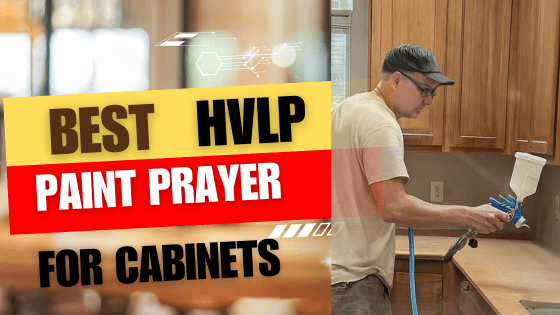Best HVLP paint sprayer for cabinets

Welcome to my roundup of the Best HVLP paint sprayer for cabinets. In this post, I will highlight the key features of each sprayer to help you make an informed decision for your next project. Let’s dive in and find the perfect sprayer to elevate your cabinet finishing capabilities.
Wagner FLEXiO 570 HVLP Paint Sprayer
5 used from $39.88
The Wagner Flexio 570 Handheld HVLP Paint Sprayer is a versatile tool suitable for various indoor and outdoor painting projects. Its user-friendly adjustments allow for complete control with low overspray and consistent coverage. The iSpray nozzle delivers a professional finish, making it ideal for broad surfaces like walls, ceilings, siding, and fences. The powerful X-Boost turbine provides unmatched power, while the easy cleaning process makes maintenance hassle-free. With the flexibility to spray most unthinned paints, this sprayer is a practical choice for DIY enthusiasts looking for fast and efficient results.
Wagner FLEXiO 595 HVLP Paint Sprayer
$182.87 in stock
9 used from $120.00
The Wagner Spraytech 02419307 FLEXiO 595 Handheld HVLP Paint Sprayer is a powerful tool that allows you to apply coatings quickly and efficiently. Its X-Boost turbine enables you to spray most unthinned paints and stains with ease, providing a smooth finish for both interior and exterior projects such as furniture, cabinets, walls, fences, and more. The lightweight design reduces user fatigue, while the adjustable settings cater to your specific project requirements. With two nozzles included, the iSpray nozzle for broad surfaces and the Detail Finish nozzle for fine finishes, this sprayer offers versatility and convenience. Cleanup is a breeze, making it a great choice for DIY enthusiasts looking for professional results.
Wagner Control Pro 130 Paint Sprayer
$193.00 in stock
5 used from $188.82
The Wagner Spraytech 0580678 Control Pro 130 Power Tank Paint Sprayer is a high-efficiency airless sprayer that makes painting large surfaces a breeze. With up to 55% less overspray than traditional methods, it’s perfect for covering exterior walls, decks, and even kitchen cabinets. Despite a learning curve, its fast application speed and professional-level results make it a valuable tool for DIY projects or home improvement tasks. Plus, easy cleanup and compatibility with various accessories enhance its versatility and user-friendliness. This sprayer offers efficient paint application and a smooth finish, revolutionizing your painting experience.
Wagner FLEXiO 5000 Stationary Paint Sprayer
$230.79 in stock
6 used from $190.18
The Wagner Spraytech 0529091 FLEXiO 5000 Stationary HVLP Paint Sprayer is a versatile tool designed for both indoor and outdoor use. Equipped with two nozzles – the iSpray nozzle for broad surface coverage and the Detail Finish nozzle for fine finishing projects, this sprayer ensures improved spray patterns and concentrated material output for efficient coverage. The X-Boost Turbine allows you to spray unthinned materials directly from the can, offering full adjustability and minimal overspray. The unit’s innovative design places the turbine on the ground, reducing hand fatigue during long projects. It is perfect for various projects such as painting furniture, walls, cabinets, trim, and more, making it a valuable addition to any DIY enthusiast’s toolkit.
Graco TrueCoat 360 Paint Sprayer
$241.00 in stock
4 used from $220.00
As a DIY enthusiast tackling various household projects, the Graco 26D283 TrueCoat 360 Variable Speed Paint Sprayer is an ideal choice for a smooth and efficient painting experience. With a 1-10 Project Pace Control, you can easily adjust the speed to suit different tasks, from detailed cabinet doors to larger surfaces like walls and fences. Its innovative features, such as the VacuValve and FlexLiner System, make setup and operation effortless. Reviews highlight its ease of use, versatility, and minimal overspray, making it a practical and reliable tool for painting projects up to 2 gallons in size.
Top Cabinet Sprayer Brands
Step-by-Step Guide to Painting Kitchen Cabinets using a Paint Sprayer
Common Questions about Cabinet Sprayers
Can a sprayer be used on all types of cabinet materials?
A sprayer can be used on various types of cabinet materials, such as wood, MDF, metal, and plastic. However, it is essential to consider the type of material, its condition, and the type of paint or finish you are applying. Some materials may require specific preparation or priming before using a sprayer to ensure a smooth and durable finish. Always read the manufacturer’s guidelines and test a small area first to check compatibility.
When using a sprayer on cabinets, there are specific techniques that can help achieve a professional-looking finish. One essential technique is to properly prepare the surface by cleaning and sanding the cabinets to ensure a smooth finish. It’s important to select the right spray tip size and pressure settings for the type of paint or finish you are using. Additionally, maintaining a consistent distance from the surface while spraying and using smooth, overlapping strokes can help prevent drips or streaks. Proper ventilation and wearing protective gear are also essential for safety. Overall, following these techniques can help you achieve a great result when using a sprayer on cabinets.
Some recommended brands or models of sprayers for cabinets include Graco Magnum, Wagner Control Spray, Fuji Spray Mini-Mite, and HomeRight Super Finish Max. These brands offer different features and price points to suit various needs and preferences when it comes to painting cabinets. It’s essential to consider factors like your budget, the size of the project, and the type of finish you want to achieve when selecting a sprayer.
When using a sprayer to paint cabinets, it is important to prepare them differently compared to brush or roller application. Firstly, you should thoroughly clean and degrease the cabinets to ensure the paint adheres properly. Next, make sure to remove all hardware and tape off any areas you don’t want to paint. It is also recommended to sand the cabinets lightly to create a better surface for the paint to bond to. Proper preparation is key to achieving a smooth and professional finish when using a sprayer.
Yes, when it comes to painting cabinets with a sprayer, it’s recommended to use specially formulated cabinet or trim paints. These paints are typically designed to provide a durable finish that can withstand the rigors of daily use in a kitchen or bathroom. Some brands may offer specific products labeled as “cabinet and trim paint” that work well with sprayers, providing a smooth and professional-looking finish. Additionally, choosing a paint with a semi-gloss or satin finish can help to make the cabinets easier to clean and maintain. Always follow the manufacturer’s instructions for both the paint and the sprayer to achieve the best results.
Spray painting cabinets typically takes less time compared to using a brush or roller. The process of spray painting is faster and provides a smooth, even finish. Depending on the size and number of cabinets, spray painting can take a few hours to a day, whereas using a brush or roller may take several days to complete the same job due to drying times and the need for multiple coats.
Yes of course, you can use a sprayer for cabinets even if you have no previous experience with painting or refinishing. Using a sprayer can help achieve a smooth and professional finish. However, it is important to practice on a test surface first to get the hang of it. Make sure to follow the manufacturer’s instructions, prepare the cabinets properly, and work in a well-ventilated area to ensure successful results.
When troubleshooting common issues when using a sprayer on cabinets, here are some steps you can follow:
- Check the sprayer settings: Ensure that the nozzle is set to the appropriate spray pattern and pressure for the job you are doing.
- Clean the sprayer: Make sure the sprayer is clean and free from any clogs or debris that could be affecting the spray pattern.
- Thin the paint: If the paint is too thick, it can lead to a poor spray pattern. Make sure to thin the paint according to the manufacturer’s recommendations.
- Check for proper air flow: Ensure that the air compressor is providing adequate airflow to the sprayer for a consistent spray pattern.
- Test on a scrap surface: Before spraying the cabinets, do a test spray on a scrap piece of wood or cardboard to ensure that the sprayer is working correctly.
To choose the right sprayer for your cabinet project, consider the type of paint you will be using, the size of your cabinets, and your level of experience with spraying equipment.
For oil-based paints, you will need a sprayer that can handle thicker materials like the Wagner Control Pro 130, while water-based paints can typically be used with most sprayers. HVLP (high volume low pressure) sprayers work well for cabinets as they provide a finer finish with less overspray.
If you are a beginner, consider a handheld or cup-style sprayer for ease of use. For larger projects or if you have experience, a professional-grade airless sprayer may be more efficient.
Lastly, make sure to read reviews and specifications to ensure the sprayer you choose is suitable for your specific cabinet project.
To achieve a professional finish when using a sprayer on cabinets, consider the following tips:
- Proper Preparation: Ensure the cabinets are thoroughly cleaned, sanded, and free of any dust or debris before painting.
- Use High-Quality Paint: Invest in a high-quality paint specifically designed for cabinets to achieve a smooth and durable finish.
- Practice Technique: Practice using the sprayer on a test surface to get comfortable with the spray pattern and adjust the settings as needed.
- Coat Application: Apply thin, even coats of paint to avoid drips or uneven coverage. Allow each coat to dry completely before applying the next.
- Ventilation: Work in a well-ventilated area to ensure proper air circulation and wear a respirator mask to protect yourself from fumes.
Yes, a sprayer can be used for both painting and staining cabinets. However, it is important to note that you may need to use different settings and techniques depending on the type of finish you are applying. Make sure to thoroughly clean the sprayer between switching from paint to stain or vice versa to avoid any unwanted mixing of products.


















Are there any warranty details available for these sprayers?
Great roundup! Can’t wait to try one of these sprayers on my next project.
I wish the article compared the prices of the different sprayers.
The recommended sprayers seem to be high quality, which is important for me.
The article helped me narrow down my choices for a cabinet sprayer. Thanks!
I appreciate the detailed pros and cons provided for each sprayer.